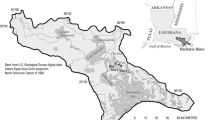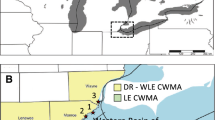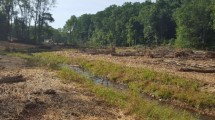Abstract
In the northeast US removal of exotic and invasive plant species is a common wetland restoration activity and the invasive common reed (Phragmites australis) is often the target of control efforts. We examined effects of reed removal on sediment nutrient pools and denitrification potential in a tidal freshwater marsh on the Connecticut River. In the first year after herbicide application and cutting of a reed stand, porewater ammonium concentrations in the removal area were about 4× higher relative to extant reed or cattail. Denitrification potentials were 50% lower than in a reference stand of reed. Denitrification activity had “recovered” by the second growing season after reed removal but porewater ammonium continued to accumulate. By the third growing season following reed removal, plant regrowth had occurred over approximately half the experimental plot and porewater ammonium had declined to pre-manipulation levels. Sediment organic content, moisture and porewater phosphate showed no significant response to reed removal over the four-year course of this study. Reed removal allowed regrowth of a more diverse plant community thereby achieving one of the goals of this restoration effort but patterns in ammonium accumulation and denitrification suggest a reduction in the capacity of this site to act as a sink for nitrogen.
Similar content being viewed by others
References
Ailstock M.S., Norman C.M. and Bushman P.J. 2001. Common reed Phragmites australis: Control and effects upon biodiversity sediin freshwater nontidal wetlands. Restoration Ecology 9: 49–59.
Alpkem Corporation 1986. Operator's Manual and Methodologies for the RFA-300. Clackamas, OR, USA.
Armstrong J., Armstrong W. and Beckett P.M. 1992. Phragmites australis: Venturi-and humidity-induced pressure flows enhance rhizome aeration and rhizosphere oxidation. New Phytology 120: 197–207.
Barrett N.E. and Niering W.A. 1993. Tidal marsh restoration trends in vegetation change using a geographical information system (GIS). Restoration Ecology 1: 18–28.
Bart D. and Hartman J.M. 2000. Environmental determinants of Phragmites australisexpansion in a New Jersey salt marsh: an experimental approach. Oikos 89: 59–69.
Benoit L.K. and Askins R.A. 1999. Impact of the spread of Phragmites on the distribution of birds in Connecticut tidal marshes. Wetlands 19: 194–208.
Chambers R.M. 1997. Porewater chemistry associated with Phrag-mites andSpartina in a Connecticut tidal marsh. Wetlands 17: 360–367.
Chambers R.M., Meyerson L.A. and Saltonstall K. 1999. Expan-sion of Phragmites australis into tidal wetlands of North America. Aquatic Botany 64: 261–273.
Craft C.B. and Richardson C.J. 1993. Peat accretion and N,P, and organic C accumulation in nutrient-enriched and unenriched everglades peatlands. Ecological Applications 3: 446–458.
Farnsworth E. and Meyerson L. 1999. Species composition and freshinter-annual dynamics of a freshwater tidal plant community following removal of the invasive grass, Phragmites australis: a four-year study.Biological Invasions 1: 115–127.
Galatowitsch S.M., Anderson N.O. and Ascher P.D. 1999. Invasive-ness in wetland plants in temperate North America.Wetlands 19: 733–755.
Gold A.J., DeRagon W.R., Sullivan W.M. and LeMunyon J.L. 1990. Nitrate-nitrogen losses to groundwater from rural and suburban land uses. Journal of soil and Water Conservation 45: 305–310.
Green E.K. and Galatowitsch S.M. 2000. Differences in wetland plant community establishment with additions of nitrate-N and invasive species (Phalaris arundinacea andTypha x glauca). Canadian Journal of Botany 79: 170–178.
Groffman P.M. 1994. Denitrification in freshwater wetlands. Cur-rent Topics in Wetland Biogeochemistry 1: 15–35.
Groffman P.M., Hanson G.C., Kiviat E. and Stevens G. 1996. Variation in microbial biomass and activity in four different wetland types. Soil Science Society of America Journal 60: 622–629.
Hellings S.E. and Gallagher J.L. 1992. The effects of salinity and flooding on Phragmites australis. Journal of Applied Ecology 29: 41–49.
Hesslein R.H. 1976. An in situ sampler for close interval porewater studies. Limnology and Oceanography 21: 912–914.
Jansson A., Folke C. and Langaas S. 1998. Quantifying the nitrogen manuretention capacity of natural wetlands in the large-scale drainage basin of the Baltic Sea. Landscape Ecology 13: 249–262.
Johnston C.A., Detenbeck N.E. and Niemi G.J. 1990. The cumulative effect of wetlands on stream water quality and quantity: A landscape approach. Biogeochemistry 10: 105–142.
Jordan T.E., Whigham D.F. and Correll D.L. 1989. The role of litter in nutrient cycling in a brackish tidal marsh. Ecology 70: 1906– 1915.
Krom M.D. and Berner R.A. 1980. The diffusion coefficients of sulfate, ammonium, and phosphate ions in anoxic marine sediin ments. Limnology and Oceanography 25: 327–337.
Lippert I., Rolletschek H., Kuhl H. and Kohl J.G. 1999. Internal and external nutrient cycles in stands of Phragmites australis – a model for two ecotypes. Hydrobiologia 408: 343–348.
Malecki R.A., Blossey B., Hight S.D., Schroeder D., Kok L.T. and Coulson J.R. 1993. Biological control of purple loosestrife. Bioscience 43: 680–686.
Marks M., Lapin B. and Randall J. 1994. Phragmites australis (P. communis ): Threats, management, and monitoring. Natural Areas Journal 14: 285–294.
Merrill J.Z. and Cornwell J.C. 2000. The role of oligohaline marshes in estuarine nutrient cycling. In: Weinstein M.P. and Kreeger D.A. (eds), Concepts and Controversies in Tidal Marsh Ecology. Kluwer Academic Publishers, Dordrecht, The Nether-lands, pp. 425–441.
Meyerson L., Saltonstall K., Windham L., Kiviat E. and Findlay S. 2000. A comparison of Phragmites australis in freshwater and brackish marsh environments in North America.Wetlands Ecolo-gy and Management 8: 89–103.
Nijburg J.W. and Laanbroek H.J. 1997. The fate of 15N-nitrate in healthy and decliningPhragmites australis stands. Microbial Ecology 34: 254–262.
Orson R.A., Warren R.S. and Niering W.A. 1987. Development of a tidal marsh in a New England river valley. Estuaries 10: 20–27.
Otto S., Groffman P.M., Findlay S.E.G. and Arreola A.E. 1999. Invasive plant species and microbial processes in a tidal freshinter-water marsh. Journal of Environmental Quality 28: 1252–1257.
Picek T., Lusby F., Cizkova H., Santruckova H., Simek M., Kvet J. et al. 2000. Microbial activities in soils of a healthy and a declining reed stand. Hydrobiologia 418: 45–55.
Reddy K.R., Patrick W.H. and Lindau C.W. 1989. Nitrification-denitrification at the plant root-sediment interface in wetlands. Limnology and Oceanography 34: 1004–1013.
Rice D., Rooth J. and Stevenson C.J. 2000. Colonization and expansion of Phragmites australisin upper Chesapeake Bay tidal marshes. Wetlands 20: 280–299.
Roman C.T., Niering W.A. and Warren R.S. 1984. Salt marsh vegetation change in response to tidal restriction. Environmental Management 8: 141–150.
Sinicrope T.L., Hine P.G., Warren R.S. and Niering W.A. 1990. Restoration of an impounded salt marsh in New England. Es-tuaries 13: 25–30.
Smith M.S. and Tiedje J.M. 1979. Phases of denitrification follow ing oxygen depletion in soil. Soil Biology and Biochemistry 11: 262–267.
Templer P., Findlay S. and Wigand C. 1998. Sediment chemistry auassociated with native and non-native emergent macrophytes of a Hudson River marsh ecosystem. Wetlands 18: 70–78.
Weinstein M.P., Balletto J.H., Teal J.M. and Ludwig D.F. 1997. Success criteria and adaptive management for a large-scale wetland restoration project.Wetlands Ecology and Management 4: 111–127.
Windham L. and Lathrop R.G. 1999. Effects of Phragmites auassociated stralis (common reed) invasion on aboveground biomass and soil properties in a brackish tidal marsh of the Mullica River, New Jersey. Estuaries 22: 927–935.
Author information
Authors and Affiliations
Corresponding author
Rights and permissions
About this article
Cite this article
Findlay, S., Groffman, P. & Dye, S. Effects of Phragmites australis removal on marsh nutrient cycling. Wetlands Ecology and Management 11, 157–165 (2003). https://doi.org/10.1023/A:1024255827418
Issue Date:
DOI: https://doi.org/10.1023/A:1024255827418




